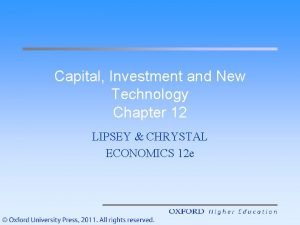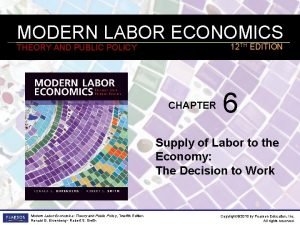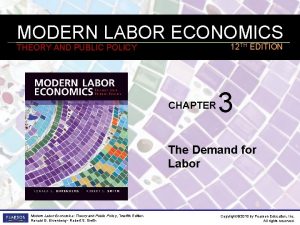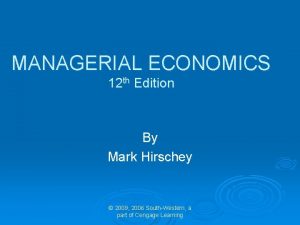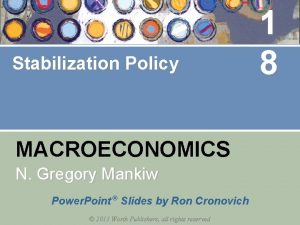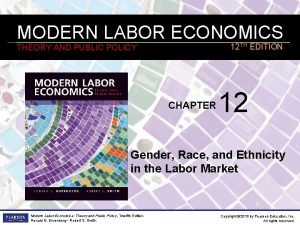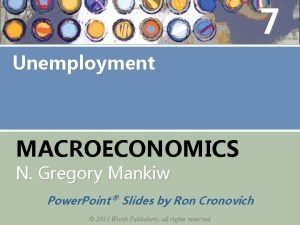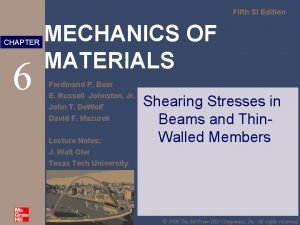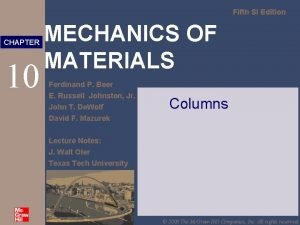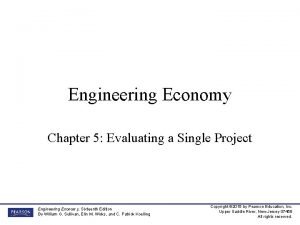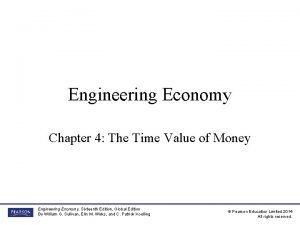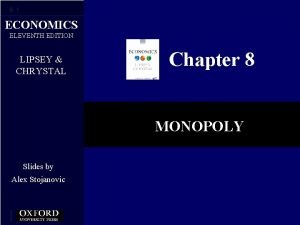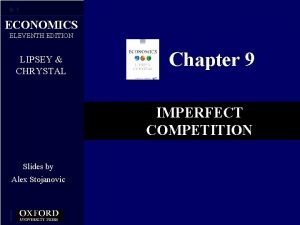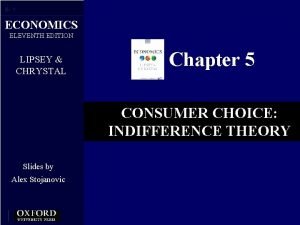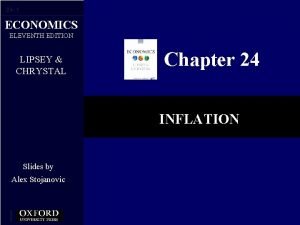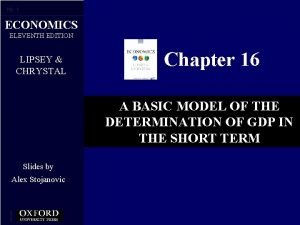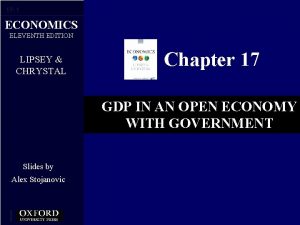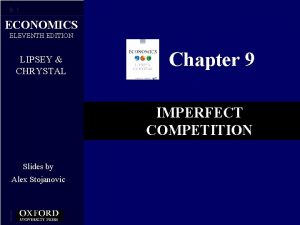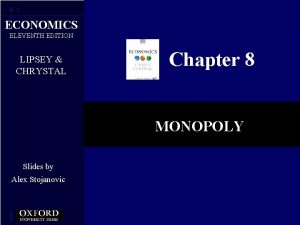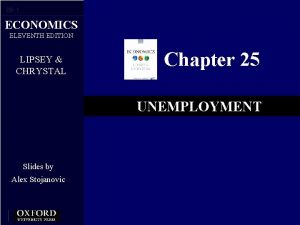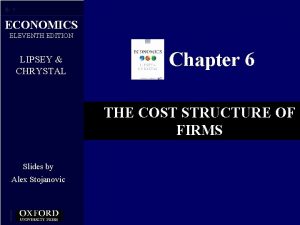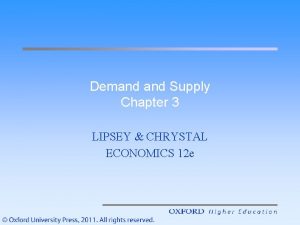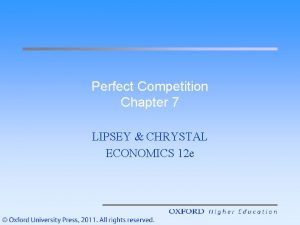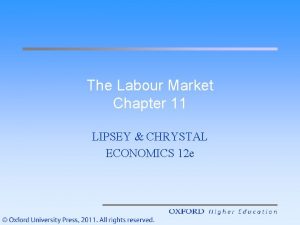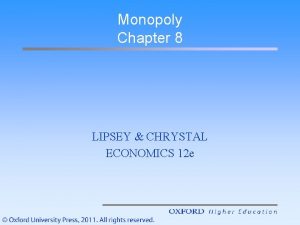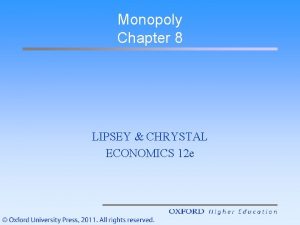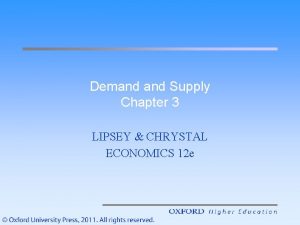4 1 ECONOMICS ELEVENTH EDITION LIPSEY CHRYSTAL Chapter














































- Slides: 46

4 - 1 ECONOMICS ELEVENTH EDITION LIPSEY & CHRYSTAL Chapter 4 ELASTICITY OF DEMAND SUPPLY Slides by Alex Stojanovic

4 - 2 Learning Outcomes • How the sensitivity of quantity demanded to a change in price is measured by the elasticity of demand what factors influence it • How elasticity is measured at a point or over a range • How income elasticity is measured and how it varies with different types of goods • How elasticity of supply is measured and what it tells us about conditions of production • Some of the difficulties that arise in trying to estimate various elasticities from sale data

4 - 3 Calculation of Two Demand Elasticities Original New % change Elasticity Good A Quantity 100 95 -5% Price £ 1. 10 10% Quantity 200 140 -30% Price £ 5 £ 6 20% -5/10 = - 0. 5% Good B -30/20 = - 1. 5%

4 - 4 Calculation of Two Demand Elasticities · Elasticity is calculated by dividing the percentage change in quantity by the percentage change in price. · Consider good A. · A rise in price of 10 p on £ 1 or 10 percent causes a fall in quantity of 5 units from 100, or 5 percent. · Dividing the 5 percent deduction in quantity by the 10 percent increase in price gives an elasticity of 0. 5. · Consider good B. · A 30 percent fall in quantity is caused by a 20 percent rise in price, making elasticity – 1. 5

Three Constant-elasticity Demand Curves D 0 Price 4 - 5 Quantity

Three Constant-elasticity Demand Curves D 0 D 1 Price 4 - 6 Quantity

Three Constant-elasticity Demand Curves D 0 Price 4 - 7 D 1 p 0 D 2 Quantity

4 - 8 Three Constant-elasticity Demand Curves · Curve D 1 has zero elasticity: the quantity demanded does not change at all when price changes. · Curve D 2 has infinite elasticity at the price p 0: a small price increase from p 0 decreases quantity demanded from an indefinitely large amount to zero. · Curve D 3 has unit elasticity: a given percentage increase in price brings an equal percentage decrease in quantity demanded at all points on the curve. · Curve D 3 is a rectangular hyperbola for which price times quantity is a constant.

Elasticity on a Linear Demand Curve 4 - 9 Price D 0 Quantity

Elasticity on a Linear Demand Curve 4 - 10 Price D A p 0 q Quantity

Elasticity on a Linear Demand Curve 4 - 11 D Price B p A q p 0 q Quantity

4 - 12 Elasticity on a Linear Demand Curve · Starting at point A and moving to point B, the ratio p/ q is the slope of the line. · Its reciprocal q/ p is the first term in the percentage definition of elasticity. · The second term in the definition is p/q, which is the ratio of the coordinates of point A. · Since the slope p/ q is constant, it is clear that the elasticity along the curve varies with the ratio p/q. · This ratio is zero where the curve intersects the quantity axis and ‘infinity’ where it intersects the price axis.

Two Intersecting Demand Curves Price 4 - 13 Ds 0 Quantity Df

Two Intersecting Demand Curves Price 4 - 14 A p p Ds 0 q Quantity Df

Two Intersecting Demand Curves 4 - 15 p 1 Price p 2 p A p Ds 0 q Quantity Df

4 - 16 Two Intersecting Demand Curves · At the point of intersection of two demand curves, the steeper curve has the lower elasticity. · At the point of intersection p and q are common to both curves, and hence the ratio p/q is the same on both curves. · Therefore, elasticity varies only with q/ p. · The absolute value of the slope of the steeper curve, p 2/ q, is larger than the absolute value of the slope, pl/ q, of the flatter curve. · Thus, the absolute value of the ratio q/ p 2 on the steeper curve is smaller than the ratio q/ p 1 on the flatter curve. · So that elasticity is lower.

Elasticity on a Nonlinear Curve 4 - 17 Price Demand 0 q

Elasticity on a Nonlinear Curve 4 - 18 Price Demand A p B 0 q Quantity

Elasticity on a Nonlinear Curve 4 - 19 Price Demand A p C B 0 q Quantity

Elasticity on a Nonlinear Curve 4 - 20 Demand Price D A p C B 0 q Quantity

Elasticity on a Nonlinear Curve 4 - 21 Demand E Price D A p C B 0 q Quantity

4 - 22 Elasticity on a Nonlinear Demand Curve · Elasticity measured from one point on a nonlinear demand curve and using the percentage formula varies with the direction and magnitude of the change being considered. · Elasticity is to be measured from point A, so the ratio p/q is given. · The ratio pl q is the slope of the line joining point A to the point reached on the curve after the price has changed. · The smallest ratio occurs when the change is to point C. · The highest ratio when it is to point E. · Since the term in the elasticity formula, q/ p, is the reciprocal of this slope, measured elasticity is largest when the change is to point C and smallest when it is to point E.

Elasticity by the Exact Method 4 - 23 Price D 0 Quantity

Elasticity by the Exact Method 4 - 24 Price D a b’ 0 Quantity

Elasticity by the Exact Method 4 - 25 Price D a b” 0 Quantity b’

Elasticity by the Exact Method 4 - 26 Price D a p q 0 Quantity b” b’

4 - 27 Elasticity by the Exact Method · In this method the ratio q/ p is taken as the reciprocal of the slope of the line that is tangent to point a. · Thus there is only one measure elasticity at point a. · It is p/q multiplied by q/ p measured along the tangent T. · There is no averaging of changes in p and q in this measure because only one point on the curve is used.

Short-run and Long-run Demand Curves Price 4 - 28 DL Quantity

Short-run and Long-run Demand Curves Price 4 - 29 E 0 p 0 Dl Dso q 0 Quantity

Short-run and Long-run Demand Curves 4 - 30 Price p 1 E’ 1 E 0 p 0 Dl Ds 1 q 1 Quantity q’ 1 q 0 Dso

Short-run and Long-run Demand Curves 4 - 31 E 2 E’ 2 p 2 E 1 Price p 1 E’ 1 E 0 p 0 Dl Ds 2 q’ 2 q 1 Quantity Ds 1 q’ 1 q 0 Dso

4 - 32 Short-run and Long-run Demand Curves · DL is the long-run demand curve showing the quantity that will be bought after consumers become fully adjusted to each given price. · Through each point on DL there is a short-run demand curve. · It shows the quantities that will be bought at each price when consumers are fully adjusted to the price at which that particular short-run curve intersects the long-run curve. · So at every other point on the short run curve consumers are not fully adjusted to the price they face, possibly because they have an inappropriate stock of durable goods.

4 - 33 Short-run and Long-run Demand Curves · For example, when consumers are fully adjusted to price p 0 they are at point E 0 consuming q 0. · Short-run variations in price then move them along the short run demand curve DS 0. · Similarly, when they are fully adjusted to price p 1, they are at E 1 and short-run price variations move them along DS 1. · The line DS 2 shows short-run variations in demand when consumers are fully adjusted to price p 2.

The Relation Between Quantity Demanded and Income Quantity 4 - 34 0 Income

The Relation Between Quantity Demanded and Income 4 - 35 Quantity qm Zero income elasticity 0 y 1 Income y 2

The Relation Between Quantity Demanded and Income 4 - 36 qm Quantity Positive income elasticity Zero income elasticity 0 y 1 Income y 2

The Relation Between Quantity Demanded and Income 4 - 37 qm Quantity Positive income elasticity Zero income elasticity 0 Negative income elasticity [inferior good] y 1 Income y 2

4 - 38 The Relation Between Quantity Demanded and Income · Normal goods have positive income elasticities. · Inferior goods have negative elasticities. · Nothing is demanded at income less than y 1, so for incomes below y 1 income elasticity is zero. · Between incomes of y 1 and y 2 quantity demanded rises as income rises, making income elasticity positive. · As income rises above y 2, quantity demanded falls from its peak at qm, making income elasticity negative.

4 - 39 Price S 1 Three Constant-elasticity Supply Curves S 2 p 1 q 1 Quantity [ii]. Infinite Elasticity [i]. Zero Elasticity Price S 3 Quantity [iii]. Unit Elasticity Quantity

4 - 40 Price S 1 Three Constant-elasticity Supply Curves S 2 p 1 q 1 [ii]. Infinite Elasticity Quantity [i]. Zero Elasticity Price S 3 p q q [iii]. Unit Elasticity p Quantity

4 - 41 Three Constant-elasticity Supply Curves · Curve S 1, has a zero elasticity, since the same quantity q 1, is supplied whatever the price. · Curve S 2 has an infinite elasticity at price p 1; nothing at all will be supplied at any price below p 1, while an indefinitely large quantity will be supplied at the price of p 1. · Curve S 3, as well as all other straight lines through the origin, has a unit elasticity, indicating that the percentage change in quantity equals the percentage change in price between any two points on the curve.

Changes in demand for newspaper 4 - 42 Price Pre-Sep. ’ 93 Average daily sales Post-Sep. ’ 93 Pre-Sep. ’ 93 Percent change Post-Sep. ’ 93 Price Sales -40. 0 +17. 5 The Times 45 p 376, 836 2, 196, 464 Guardian 45 p 420, 154 401, 705 0. 0 -4. 50 Daily Telegraph 45 p 1, 137, 375 1, 017, 326 0. 0 -1. 95 Independent 50 p 362, 099 0. 0 -15. 20 2, 196, 464 2, 179, 039 50 p

4 - 43 CHAPTER 4: ELASTICITY OF DEMAND SUPPLY Demand Elasticity • Elasticity of demand [also called price elasticity of demand] is defined as the percentage change in price that brought it about. • When the percentage change in quantity is less than the percentage change in price, demand is inelastic and a fall in price lowers the total amount spent on the product. • When the percentage change in quantity is greater than the percentage change in price, demand is elastic and a fall in price raises total spending on the product. • A more precise measure that gives unique value for elasticity at any point on any demand curve replaces q/ p measured between two points on the curve with q/ p measured along the tangent to the curve at the point in question [symbolised by q/ p].

4 - 44 CHAPTER 4: ELASTICITY OF DEMAND SUPPLY • The main determinant of the price elasticity of demand is the availability of substitutes for the product. • Any one of a group of close substitutes will have a more elastic demand than the group as a whole. • Elasticity of demand tends to be greater the longer the time over which adjustment occurs. • Items that have a few substitutes in the short run may develop ample substitutes when consumers and producers have time to adapt. • Income elasticity is the percentage change in quantity demanded divided by the percentage change in income that brought it about. • The income elasticity of demand for a product will usually change as income varies.

4 - 45 CHAPTER 4: ELASTICITY OF DEMAND SUPPLY • Cross-elasticity is the percentage change in quantity demanded divided by the percentage change in the price of some other product that brought it about. • Products that are substitutes for one another have positive cross-elasticities; products that complement one another have negative cross-elasticities. Supply Elasticity • Elasticity of supply measures the ratio of the percentage change in the quantity supplied of a product to the percentage change in its price. • A commodity’s elasticity of supply depends on how easy it is to shift resources into the production of that commodity and how the costs of producing the commodity vary as its production varies.

4 - 46 CHAPTER 4: ELASTICITY OF DEMAND SUPPLY Measurement of Demand Supply • Over the years economists have measured many price, income, and cross-elasticities of demand. • Being able to do so requires the use of statistical techniques to measure the separate influences of each of several variables when all are changing at once. • It also requires a solution of the identification problem, which refers to measuring the separate shapes of the demand supply curves. • This can not be done from price and quantity data alone.
 Paul lipsey
Paul lipsey Management eleventh edition stephen p robbins
Management eleventh edition stephen p robbins Management eleventh edition
Management eleventh edition Management eleventh edition
Management eleventh edition Management eleventh edition stephen p robbins
Management eleventh edition stephen p robbins Chadha committee
Chadha committee Eleventh 5 year plan
Eleventh 5 year plan Eleventh plan
Eleventh plan For his eleventh birthday elvis presley
For his eleventh birthday elvis presley Using mis 10th edition
Using mis 10th edition Zulily case study
Zulily case study Principle of management oxford fajar pdf
Principle of management oxford fajar pdf Modern labor economics 12th edition solution
Modern labor economics 12th edition solution Modern labor economics 12th edition pdf
Modern labor economics 12th edition pdf Economics michael parkin 13th edition
Economics michael parkin 13th edition Managerial economics hirschey
Managerial economics hirschey Markup economics
Markup economics Principles of economics mankiw 9th edition ppt
Principles of economics mankiw 9th edition ppt Principles of economics sixth edition
Principles of economics sixth edition Modern labor economics 12th edition
Modern labor economics 12th edition Principles of economics mankiw 9th edition ppt
Principles of economics mankiw 9th edition ppt Economics and business economics maastricht
Economics and business economics maastricht Non mathematical economics
Non mathematical economics Organizational behavior chapter 1
Organizational behavior chapter 1 Organic chemistry (3rd) edition chapter 1 problem 16s
Organic chemistry (3rd) edition chapter 1 problem 16s Mechanics of materials 6th edition solutions chapter 10
Mechanics of materials 6th edition solutions chapter 10 Mechanics of materials 9th edition solution chapter 7
Mechanics of materials 9th edition solution chapter 7 Beer johnston
Beer johnston Mechanics of materials chapter 5
Mechanics of materials chapter 5 Mechanics of materials 7th edition solutions chapter 10
Mechanics of materials 7th edition solutions chapter 10 Everything's an argument chapter 1 summary
Everything's an argument chapter 1 summary Ifsta 7th edition chapter 6
Ifsta 7th edition chapter 6 Engineering economy 16th edition chapter 5 solutions
Engineering economy 16th edition chapter 5 solutions Engineering economy 16th edition chapter 4 solutions
Engineering economy 16th edition chapter 4 solutions Business essentials 12th edition
Business essentials 12th edition Appraisals in lazarus theory of emotion
Appraisals in lazarus theory of emotion Prehospital emergency care 11th edition
Prehospital emergency care 11th edition Do role requirements change in different situations
Do role requirements change in different situations Carboxylic acid h3o+ reaction
Carboxylic acid h3o+ reaction Landmarks in humanities 5th edition chapter 1
Landmarks in humanities 5th edition chapter 1 Infants children and adolescents 8th edition
Infants children and adolescents 8th edition Beer mechanics of materials 6th edition chapter 4 solutions
Beer mechanics of materials 6th edition chapter 4 solutions Mechanics of materials 6th edition beer solution chapter 3
Mechanics of materials 6th edition beer solution chapter 3 Understanding human communication 14th edition chapter 1
Understanding human communication 14th edition chapter 1 Understanding business 12th edition chapter 1
Understanding business 12th edition chapter 1 Security in computing 5th edition ppt
Security in computing 5th edition ppt Financial accounting ifrs 4th edition chapter 12
Financial accounting ifrs 4th edition chapter 12
